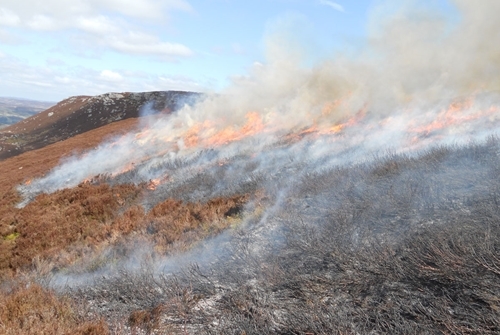
By Dr. Jen Brewin, Writer and Research Specialist
4 minute read
Policy makers must broaden their view of upland management
As the beginning of the heather burning season approaches, upland land managers will be planning the tasks ahead to look after their land and their birds with an element of uncertainty for the future. The discussion around prescribed heather burning on UK moorland has raged this year; with a Westminster debate, IUCN UK peatland programme position statement and multiple scientific papers on the topic as well as widespread media coverage.
At first sight, you may be led to believe that the evidence is clear on the matter, one way or another. As with many contentious subjects, those that are firmly “for” or “against” paint a black and white picture.
However, a leading expert from the University of York is concerned enough about the polarisation of this issue, as well as the oversimplification of the very complex and still limited science that he has published two papers this year to bring it to the attention of policy makers. The matter was also highlighted in a crucial seminal publication by many other researchers in 2016, clearly outlining that the evidence on burning is far from clear and requires further research.
Associate Prof Andreas Heinemeyer leads Peatland-ES-UK, a planned twenty-year project which aims to study the effects of heather burning on moorland versus alternative cutting over the course of an entire management cycle with relation to biodiversity, carbon, greenhouse gases and water. Recently, Dr Heinemeyer has co-authored a summary of the evidence, discussing our current knowledge about prescribed vegetation burning and current alternatives.
He voices concerns that the recently published IUCN UK Peatland Programme’s position statement presents a simplified picture of the science around heather burning, painting it misleadingly as a management tool that is only ever damaging. Although Dr Heinemeyer is neither pro- nor anti-burning himself, and although he agrees with the IUCN’s assessment in several areas, he highlights many more in which he feels the assertions are unverified, the claimed scientific consensus is lacking, or the evidence presented to support the argument is not robust.
In another paper, published in the scientific journal Wetlands, Dr Heinemeyer and co-author expand on these threads and discusses each of the IUCN UK Peatlands Programme’s position statements in turn to assess and clarify the evidence base behind them. Often, their opinion is at odds with the IUCN’s claims.
Dr Heinemeyer is airing these views because he has serious concerns. The IUCN UK Peatlands Programme is a highly respected and influential body, one of the UK’s most prominent peatland conservation organisations, and their document is likely to be consulted by policymakers. If the evidence base is overstated, or even misrepresented, and the arguments are oversimplified, any change to policy that followed would be without a good understanding of the impacts.
Any changes to heather management should be based on robust evidence, and Dr Heinemeyer’s summary appears to challenge the conviction expressed to date by policymakers with respect to the potential effects of managed heather burning.
Another very important point from these papers is that the alternative management techniques that may take its place (or lack of them, in the case of rewilding) are even less well understood than prescribed burning itself, so the effects of forcing a widespread change to uplands management such as removing prescribed burning are extremely unclear. When carried out according to best practice, prescribed heather burning should, on the basis of the current evidence base, remain a valuable tool available to moorland managers.
Unfortunately, the debate around prescribed heather burning has become so polarised that objective and rigorous assessments of the evidence such as this are rare. Some scientists are so concerned about this that scientific papers have even been published calling for a genuine, unbiased discussion to further our understanding as opposed to the emotive headlines and entrenched positions that have become so common in this area.
We must hope that policymakers heed these calls and pay attention to all the science and the critical reviews we have, as well as noting where our knowledge is lacking, to help them form a balanced opinion.